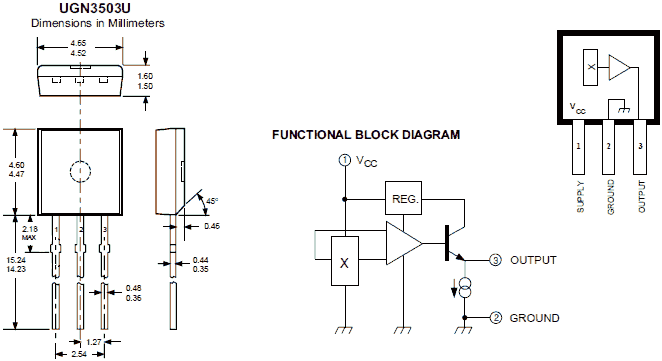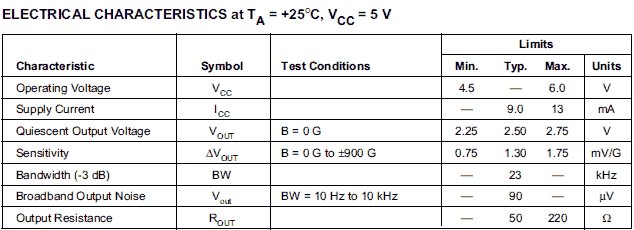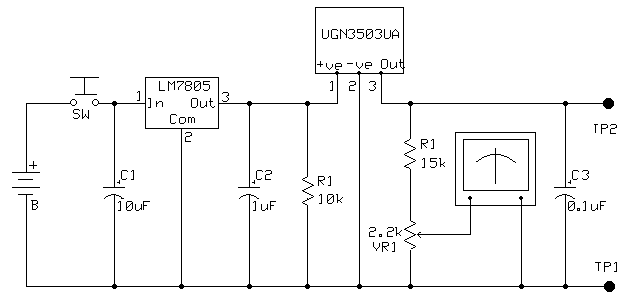 |
|
|
|
Site Navigation
Projects & Information
»General Information»Wind turbine Projects »The F&P Smartdrive »Electronic projects »Microcontroller projects »Miscellaneous Kits & Parts
»Basicly Natural Pty Ltd»PVC & Aluminium blades »Scale model farm windmills »Price Watch Discussion Forums
Handy Links
»Wind»Solar »Electric Vehicles »Electronics »Micro Controllers »General Interrest About TheBackShed Getting Started Privacy Policy |
A Gauss Meter is handy when you want to know what end of a magnet is a North or South pole, and when you want to test magnets for strength, especially if they may have been heat damaged. The heart of the meter is a UGN3503U or similar hall sensor. The UGN3503U is a linear hall sensor, meaning its output level changes with magnet Gauss changes, and the device can be sourced from most electronics suppliers, like Jaycar, Altronics, Farnell, etc..
Below is the circuit I used for my Gauss Meter.
The circuit uses a 9v batter for power, and a push button switch to power it up, so I cant forget to turn it off. A LM7805 regulator provides the 5v for the hall sensor. C1, C2 and R1 help keep the regulator regulating. C1 and C2 values are not critical, I ended up using a 22uF for C1 and 0.47uF for C2, whatever I could find in the junk box. C1 and C2 voltage should be 15v or higher, again, not critical. I have seen circuits where C1 and C2 are left out, but this is not a good idea, the LM7805 can go into oscillation without any filter caps. This regulated 5 volts is fed to the hall sensor's pins 1 and 2, and its output, pin 3, is our detected magnet gauss level. With no magnet present, the hall sensor will supply 2.5v on its output. If we place a magnets N pole on the back of the hall sensor ( the back being the side without any text stamped on it ), the voltage will rise above 2.5v. If we turn the magnet around so the S pole is on the back of the hall sensor, the output voltage will drop below 2.5v. How much the voltage rises or falls is dependant on the gauss measured. The UGN3503 specifications say 1.3mV per Gauss, so as an example if we get a reading of 3 volts, then we have 500mV above our null point ( 2.5v ) 500mV / 1.3 = 385G The meter I used was raided from a dead stereo system many years ago. Many of the meters from stereo's are not the best quality and usually not very linear, so I've added a couple of test points where I can attach the test leads of my digital multimeter, for when I need to make a more accurate Gauss reading. A professional analogue panel meter would work much better and give accurate readings, but I prefer to use what I have lying around. R1 was chosen through trial and error, and VR1 is used to set the meter to mid scale when no magnet is present, in effect zero'ing the meter. Next Page, putting it together
|
||
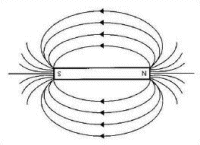
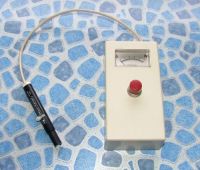 This little project is a Gauss Meter, or Flux Meter, or Magnet Polarity Indicator. Basically, it senses magnetic fields. Using a hall sensor, the meter can measure the Gauss/Flux density and polarity of a magnet. It only needs a few parts, so can be built without a circuit board.
This little project is a Gauss Meter, or Flux Meter, or Magnet Polarity Indicator. Basically, it senses magnetic fields. Using a hall sensor, the meter can measure the Gauss/Flux density and polarity of a magnet. It only needs a few parts, so can be built without a circuit board.